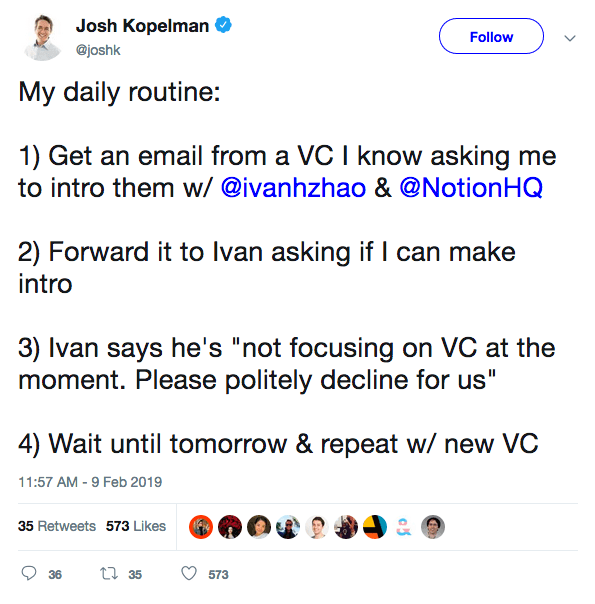Talk to VCs at Index, Sequoia and Coatue, and they’ll tell you: the best performing company in their portfolio is Notion.
With whispers of a layoff at Canva, and a wave of senior departures at Miro, Notion has firmly taken the throne as the world’s hottest PLG company.
So - in today’s piece, we’re going to break down the world’s most interesting SaaS.
Introducing Kartik
Today’s piece was written with Kartik Arora, a PM based in Delhi who has worked in SaaS at HSV Digital, TheHouseMonk, and Info Edge India.
He’s on the market now for PM roles: LinkedIn.
Today’s Post
We interviewed 3 current employees at Notion, 2 former employees, used the product for months, and read everything on the internet about the company.
Now we’re ready to present our analysis:
Notion’s story
How the founders learned from failure and grew carefully
The 7 layers of Notion’s PLG Iceberg
Detailed screen-by-screen look at how Notion does it
How Notion wins in a crowded market
Comparison of Notion across the landscape
Part 1 - Notion’s Story
People have always been looking for ways to be more productive, be it through the use of tech, strategies, or frameworks.
In the last 5 to 6 years, we have seen a litany product launches around productivity: Miro, Canva, Coda, Tome, and more.
Standing out amidst all that noise, Notion has become synonymous with productivity and collaboration.
The $10B valued company has built a product that now caters to 30M users and generates an estimated annual revenue of >$567M.
But Notion has had its share of obstacles along the way.
Chapter 1 - From a Failed Startup
The story begins in 2015 San Francisco.
Ivan Zhao and Simon Last’s previous startup, focused on No-code, failed.
“We focused too much on what we wanted to bring to the world. We needed to pay attention to what the world wanted from us.”
—Ivan Zhao
Ivan took a $150K loan from his mom, and moved with Simon to Kyoto.
It was much cheaper. And it had one benefit:
“Neither of us spoke Japanese and nobody there spoke English, so all we did was code in our underwear all day.”
—Ivan Zhao
This allowed the pair to focus on solving a problem that they had faced: workplace software was so diverse.
That’s where they dreamt up the idea of a “post-file, post-MS Office world.”
After a year of intense coding in their underwear, they launched. Notion 1.0 won #1 ProductHunt Product of the Day in 2016:
Chapter 2 - Finding Product-Market Fit
“Docs, wikis, tasks” would turn out to be a perfect description for where Notion found product-market fit.
Those three use cases all resonated with users.
The Wikis Use Case
A particularly powerful use case was Wikis.
In 2016, the main competitor for wikis was Atlassian’s Confluence. Notion was cheaper, more user-friendly, though less full-featured.
Less technical users like designers and business-people loved it. As its normal sweet spot, Atlassian was best at building for software engineers.
This helped Notion carve out a clear niche in Wikis.
Wikis also proved to be a fairly sticky way to enter companies - and would provide fuel for the company’s eventual vision of becoming a company operating system.
Amazing Launches
Notion would go on to nail its first few launches:
Commenting on blocks
Slack integration
Windows app
iOS app
By June, 2017, Notion had made a sticky product that users were using on every device.
Notion 2.0
After all the iterations, Notion 2.0 was launched in 2018.
It represented a culmination of Notion’s better way to work
“In all honesty, Notion 2.0 is really the 1.0 for us.
It finally delivers on our promise—a singular tool that handles all your work outside email and Slack.
With the addition of tables, Kanban boards, and calendars, along with the existing notes and wiki features, we think we have done it with this release—Notion is now truly the ‘all-in-one workspace.'“
It was, again, the #1 product on Product Hunt.
With merely 10 employees, Notion reached 1 million active users.
A prominent feature in The Wall Street Journal also helped.
The result was a torrent of interest from VCs to invest.
Initially, Notion stayed careful in its growth:
Chapter 3 - Building Out a PLG Engine
But after years of courage to wait, Notion accepted its first VC funding in July 2019.
Of course, it did it on its own terms: A mere $10M at a valuation of $800M.
In other words, selling just 1.2% of the company.
By that time Notion had cemented its three key use cases: notes, docs, and task management in that order.
And the differentiation was clear as well:
“Legos: very robust, simple and fun
You can customize it to the most productive tool in your workflow”
—Ivan Zhao
This allowed the company to begun to double down on growing the company.
Notion supplemented its war chest with additional VC raises:
2020 Series B - $50M
2021 Series C - $275M
The added gasoline made Notion’s flame burn even brighter.
It hired folks like:
Birkan Icacan, who has led launches of Notion’s enterprise offering
Lauryn Motamedi, who has led the evolution of Notion’s PLG offering
Notice who those folks are not: sales leaders. These are product leaders.
Chapter 4 - Present-Day Success
Now with more than 500 employees, the company has reached true scale.
Despite that, only 10% of those employees are in sales. It has stayed true to its product-led growth motion.
This is the typical march for PLG SaaS companies: Hire great product leaders in key segments to double down.
Based on the latest shared data, Notion has over 30M users, out of which 4M are paying users.
That gives it an estimated ARR of around ~$567M. (We wouldn’t be surprised if that 4M number is outdated and that figure is significantly higher.)
Public company Asana, in a similar space has a yearly revenue of $167M.
Notion has clearly “made it.” The question is not “if” it will go public, but “when.”
But how did it actually get there from a Product POV?
Part 2 - The 7 Layers of Notion’s PLG Iceberg
Let’s screen-by-screen break down each layer of Notion’s PLG Iceberg:
Core problem communication
Information for decision
Friction reduction
Value discovery
Repeat value
Monetize
Flywheel
Keep reading with a 7-day free trial
Subscribe to Product Growth to keep reading this post and get 7 days of free access to the full post archives.







